Bruce Smith, owner/operator of Fortune Sportfishing is a multi-talented guy…former long range captain; offshore and islands captain now; expert multi-species and techniques angler with IGFA records on his resume, and a badass fishing video producer…
Bruce was extremely gracious in making time and sharing information with me as I was trying to take a crasher on wahoo fishing. Some of what Bruce shared with me was published for the wahoo tips article on BD Outdoors. There was so much more though.
Here’s his “wahoo whitepaper” reprinted with his permission unedited and in its entirety…
Wahoo Stealth and other options – by Bruce A. Smith
November 28, 2010
“Wahoo, the speedsters of the sea.” The very name conjures visions of leaping missiles, scarred trolling lures, and streaking V’s of tight monofilament tearing through the water with the sound of shredding paper. Wahoo are challenging to hook, fight hard, do laps around the boat at lightening speed, form the basis of many great fish stories, and oh by the way, taste delicious for good measure. They are a substantial goal for any angler that rides on seven to ten day trips.
There was a time in my life that wahoo were king; they were all I wanted to catch. I literally had wahoo fever. I had a custom 670 H with three inch’s cut from the tip and an inch taken off the butt, a Penn 4/0 narrowed with the Newell bars, high speed gears, and with the handle extended out to the last hole. I loaded it with straight 50-pound mono, and usually had a new-fangled wahoo bomb (assembled strictly to my specifications: a fluted head, witch hair mylar, and a willow leaf blade) tied to the end. Of course there was plenty of wire thrown in the mix, usually 69 or 88 pound single strand…not very many people used seven or forty-nine strand back in those days.
Eventually big tuna caught my attention, and for the next fifteen years or so, they managed to keep it. But now wahoo have come back into fashion, at least for me. The show that these skinny fish put on when they come up on the surface iron really gets my blood pumping!
While working the shows—Fred Hall or the ISE—I often field the question “when is the best time to catch wahoo?” To this I would have to respond that earlier is better. If you can jump on a seven day in August then go for it, otherwise late September is good and into October can be great. What you are really looking for is to be one of the first boats down far enough to get into fish that haven’t been fished over. Simply put, wahoo respond unfavorably to pressure. After a few days of getting trolled over, the catch rate goes way down. You can imagine how hard it is to catch one at the “Rocks” at the end of October, with three boats there every day trying to hook and land their share of the wahoo. It’s not that they are not there or have been fished out…its not unusual to have wahoo jumping right next to the boat at this time of year. The fact is, they just won’t bite. This raises the question: “how do we catch those pressured fish?” Here are a few techniques that will help you put a few more of these tasty fish into the boat.
No wire, at least not on your casting jigs. It is a simple fact that wire reduces the number of bites you get, which means that if you want to catch a spooky wahoo, you’re going to have to consider fishing without wire.
I can already hear the gears working in your head…
Wahoo are known for their sharp dentures, and all it takes is just a nip to turn your 50-pound mono into a weightless, jig-less, wisp in the wind. Yep. That is a fact. You will lose (what sometimes can become a substantial number of) jigs fishing without wire. But compared to the number of bites received and fish landed, the rising cost of Raiders and 6x Jrs., is reasonably defrayed. Tie your mono straight to your jig. Once you lose enough jigs or you are running out of them, then wire the rest of them up. I mean you have to give something to your grandkids, right? Honestly, the only time I wire up my jigs are when I am fishing small jigs. The smaller the jig, the more it’s likely that the wahoo will swallow it instead of grabbing it the way a dog grabs a bone. This is what wahoo do with bigger jigs such as the Salas 7X. The most productive small jigs are Raiders in the 100-gram size and smaller, even as small as 85 grams. If you look at the size of these you will understand why you really need to add a small piece of 44# or 59# in front of it. Even so, you don’t want to use much, no more than 12 inches should suffice. Wahoo like small lures, and when they are feeling the fishing pressure, I would definitely have a couple of these small Raiders or Salas Christy II’s in your box. The Christy II is a hot sleeper of a jig Not many people still use them, but they work as well as they ever have, and considering that they seem to have fallen out of favor in the past fifteen years, you can probably get them pretty cheap.
Something else to consider: pressured fish have been looking at bright and shiny jigs and bombs all day long, day after day. Granted metallic and chrome colors catch many, many wahoo, I that’s all that everyone is using, however, the fish will become wary of the same thing over and over. Try going with a painted jig in muted colors such as the “Don’t ask, don’t tell” (green with a hot pink tail), purple/black swirl, “Tar Baby”(black/white swirl) and regulation blue/white or scrambled egg. These jigs serve a dual purpose, too. These are definitely the colors you want to use during kelp paddy wahoo fishing, because the dorado tend not to bite these like they do the bright and shiny candy.
One other thing before we get into the meat of this article. Surface iron can really turn the trick for wahoo that have seen too much of the same thing day after day. The standard slow wind with a good swimming jig, such as a Salas 7X, A2Z, or Tady 45 can work wonders on the wary fish. A variety of colors will work, as long as the jig swims well at a slow-to-medium retrieve.
Historically, most of us would throw straight-tied 50-pound mono, but there is a new setup becoming popular: straight super braid to wire. So far this year, I haven’t seen any indication that the wire in front of the surface iron is reducing the number of bites. I have to believe this is because the wahoo don’t see many surface lures, or perhaps it’s because the lure is being retrieved right below the surface. Whatever the reason, it works well. Even better, the thing about surface iron is that if a wahoo wants it, it will just flat out wolf it down. The fish eats the whole jig; all you can see is the top ring of the surface iron, or even just the wire coming out of its jaws. When I am fishing surface iron for wahoo, one thing I do is keep what I would call a “stiff” drag, which is heavier than normal, but at the same time a bit lighter than a “tight” drag. For one thing, this keeps the hook from straightening out, but this also makes things a bit easier on the angler too. All through the fight I keep the rod at an angle to the fish, not in the rod belt, but 45 degrees to the line going into the water. This lets the rod absorb some of the vicious head shakes the fish sends your way. And of course, the most important tip: keep winding, winding, winding, all the way to the gaff.
One interesting thing I have noticed with this rig is that the ‘hoos very seldom get their heads turned away from you, and they tend to come to the boat quicker. That can make for some exciting moments for the deckhand gaffing a hot, one-minute fish. “Whoa, look out! Wahoo coming over the rail!”
Another thing to note: after sitting in one spot for a few days, the boat becomes it’s own ecosystem. Bait accumulates, and with that follows the bigger fish. Sometimes during the day in the southern latitudes, a member of the crew will occasionally slip over the side, whether to undo a snagged fish or just to have a look around. What we see would astonish most people. It always seems that there are wahoo hanging out under or around the boat, but again they are just not biting except at certain times of the day. These are tough, wary fish, and if you want to get them to bite, you really have to scale way down. And by this I mean that you need to scale down on everything, hooks, wire, bait, leader, fluorocarbon, rod and reel. For this kind of fishing, the only thing that works is stealth.
First lets take a closer look at the Sano stealth bait leader. It’s short, just nine to twelve inches, and light. Typically the bait leader uses between 27 and 33 pound single strand wire, or 27 to 40 pound seven strand. I prefer the single strand. It’s thinner and stronger, even if it’s only good for one fish each. That’s okay, though, wire is cheap and easy to work with, and if it lands you a 40-pound fish, it’s definitely worth it. The hook can be a Mustad 94150 (sharpen these), or if you prefer a more expensive style then go with the Mustad Hoodlum, Owner Gorilla, or Flyliner. These work just as well. By the way, there’s no need for ringed hooks when using wire. In fact, the ring is redundant, as you will already have a loop in each end of the wire when you are done rigging each leader. J-hooks work better than circles in this situation. Why? For one thing circles have to work their way to the corner of the jaw before they dig in. When using wire sometimes the crimped sleeves or haywire twist will hang up in the teeth or scissor like jaws of the wahoo and never get the point into the corner of the fish’s jaw. If instead you use a J-style hook, you have a chance to hook the wahoo deeper in the softer parts of its mouth.
You can use seven strand, titanium, or single strand wire to make these leaders. Right now, though, we are going to talk about single strand. Single strand is experiencing a resurgence of popularity over the past couple of years. I find that single strand is smaller in diameter and presents a less visible profile, which in turn translates into more bites. At the hook I connect the wire with a haywire twist, and I allow for a foot long trace. At the other end, instead of having a ring (or worse, a swivel) attached, I try to make things even lower profile by making a double loop in the wire then a haywire twist. (See photo)
double loop
I coat this double loop in five minute epoxy to prevent the wire from cutting through the fluoro; the epoxy acts as a buffer of sorts. I have seen that the epoxy lasts long enough to land even the most stubborn wahoo. Given that we are fishing light gear, your drag setting will be light also. The knot connecting the wire to fluoro should be something like a Palomar or Trilene, preferably with two pieces of fluoro running through the “eye” of the wire. Use a short top-shot of 30- or 40-pound high-grade fluorocarbon, connected to 65-pound super braid and you are ready to go.
The rod and reel combo can be whatever is your favorite 30- or 40-pound outfit. My choice would be the Accurate Extreme 500N, on top of a Seeker Hercules 70M or 70H. A Cal-star 800M or 700L is also a great rod for this kind of fishing.
If you insist on using a seven-strand wire leader, all is not lost. I shy away from these because of the amount of parts involved, but they can be effective. If you use multi-strand wire, use only two sleeves, one on each end, and make your loops very small. You can use the epoxy trick with the seven-strand too, but you have to make a double overhand loop instead of a single loop. When using seven-strand, stick to small diameter sizes, 27-pound or—at the heaviest! 36-pound, and use A-1 sleeves for your crimps.
Whether you use single- or multi-strand wire, it’s better to make a loop as I’ve already described. If you must put a ring on, however, then use the smallest welded rings you can find. Important tip: Welded rings are made of round wire and won’t cut small diameter monofilament. Stamped rings are a no-no, as they have sharp edges and will bite and cut your fluoro or mono at the knot.
Sometimes you will hook a fish and when you get your leader back it looks like it got a perm, all twisted and curled up like a watch spring.
Curly wire, no bueno.
You can still use these leaders, but—very important!—you have to straighten them as best you can first. Curled up wire leaders don’t catch fish and they don’t straighten when they get in the water. The commercial tools available on the market work well enough to straighten bent wire, but for me it works best if I just go and tie a new leader on. That way I know my leader is laying out there in the water nice and straight, and I don’t have any unseen kinks or chafes on it that could cost me the next fish I hook.
This brings us to the all-important question of “do I set the hook or just keep winding when I get bit?” This tends to be a real controversy for wahoo fishermen. Of course, if you’re fishing a jig the answer is easy: you keep winding all the way to the boat once you are bit. But some bait fishermen wonder if they need to set the hook, especially since a wahoo’s jaws are so very bony. The simple answer? No, you don’t. Even though you’ll be using a J-hook, you should “set” the hook as if it was a a circle hook…and that means not setting the hook at all.
When you get bit, put your reel into gear and start turning the handle. Just reel and reel and don’t stop. When the line comes tight and starts coming off your reel, against the drag, you’ve got the fish…and chances are you’ve got it hooked in the corner of the jaw, just as if you were fishing a circle hook. Remember, just like jig fishing, keep turning that handle. Make sure the line is tight and the fish is pulling drag before you go for the rod belt. You have to stay in contact with the fish—especially with wahoo!—you need to keep your line tight in case it makes a run back at you or up the side of the boat.
When you fish light line and a wire bait leader, be ready to make a sprint the moment you hook a wahoo. These fish just take off as soon as they feel the hook, and you have to get on your horse and move with them! All those stories you’ve heard about cut anchor lines and shearing off hooked fish? They’re all true. Small diameter mono or super braid will slice through a nylon anchor line like a hot knife through butter. Really! I have seen wahoo hooked and immediately take off in a circle around the boat, cutting off five big tuna in a single pass. Be mindful, be careful, never underestimate a freshly hooked wahoo! They are the fastest game fish in the ocean. The good news is that, unlike tuna, they don’t have a great deal of stamina, and can be landed on light gear if you make the right preparations.
Thus far we have mainly been discussing fishing for wahoo off the anchor. Pressured wahoo quickly become resistant to the big trolled Maraders and big Catchy bombs. Again if you downsize, your trolling approach can bring you more bites than your trolling neighbor. The popular small trolling lures to draw strikes from skittish wahoo are:
- Braid Runners, Braid Little Speedies, and Braid Speedsters
- 2.Yo-Zuri Bonito Plug(smallest size),
- 3.medium Cow Bells (not the three pounder)Medium Catchy Spinner bombs
All of these should be rigged with smaller wire such as 190 pound seven-strand or 49-strand.
Fishing with chunks can be a great way to catch wahoo while sitting on the anchor. Wahoo relish an easy meal, and frequently appear in the chunk line if it has been sustained throughout the day. Don’t be afraid to go over to the chunk bucket and pin on a chunk on your wahoo set up (hopefully a cow tuna doesn’t seize your offering and peel off all of your line on your light tackle!). I can vividly remember a story coming from Mike (Herb) Keating, owner of the Spirit of Adventure. During a trip to an upper spot on the ridge he came across a real wad of wahoo, a big school, but after a couple of days of trolling over the top of them they quit biting the trolled lures. So he put the anchor down, caught a enough purple skipjack for bait, cut those up into chunks and proceeded to catch wahoo through remainder of his trip.
One trick that could be considered chunk fishing is to cut a sardine in half, pin one half onto your hook and throw the other half into the water. Cast your hooked piece near where you tossed the first piece and let it sink out. When wahoo feed, they cut their prey in half (or in pieces), eat one of the pieces as they fly by, then circle back around and mop up the just created chunks. The two-piece sardine trick simulates a just bitten sardine. I find it a cool trick, and more importantly, does work.
Hopefully this article opens the eyes of anglers to new and different options for targeting wahoo, rather than simply the standard run and gun type of wahoo fishing. These fish are the true rockets of the blue water, and can be caught with many different techniques. Knowing new ways to fish for them can be less taxing on your physical being…and more importantly, can help you catch more of them, even when other anglers on the boat remain frustrated.
Big Fish Happen,
Bruce A. Smith

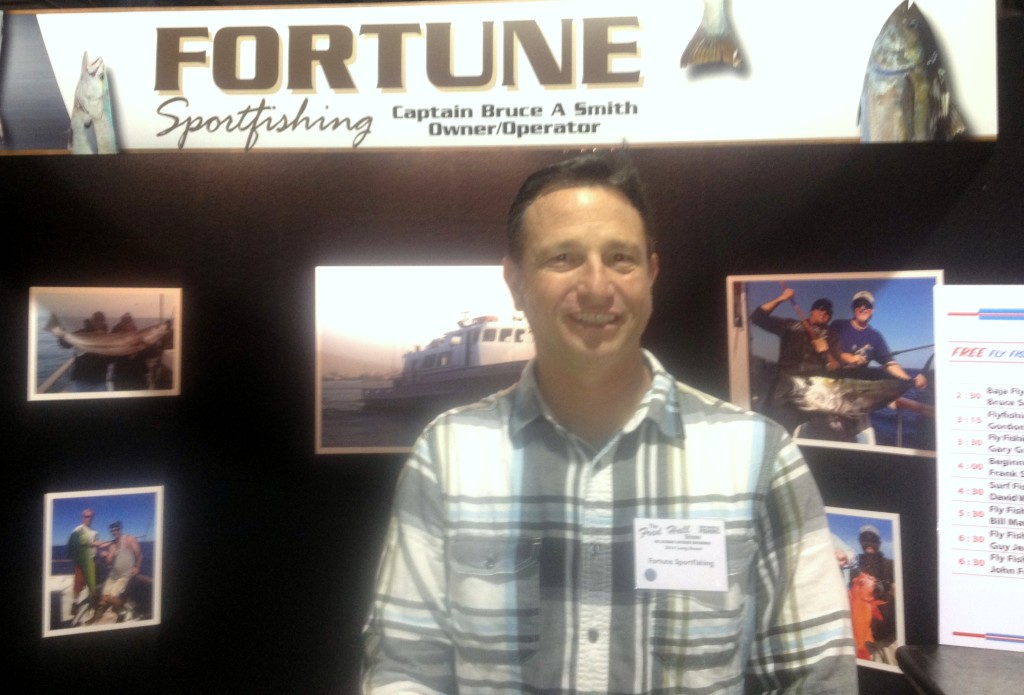






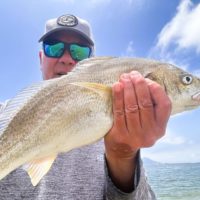
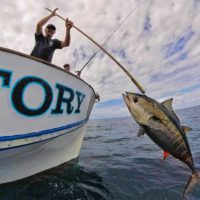
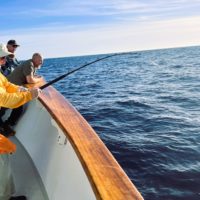





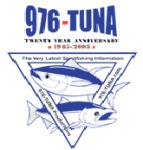
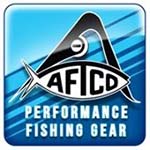
No Comments